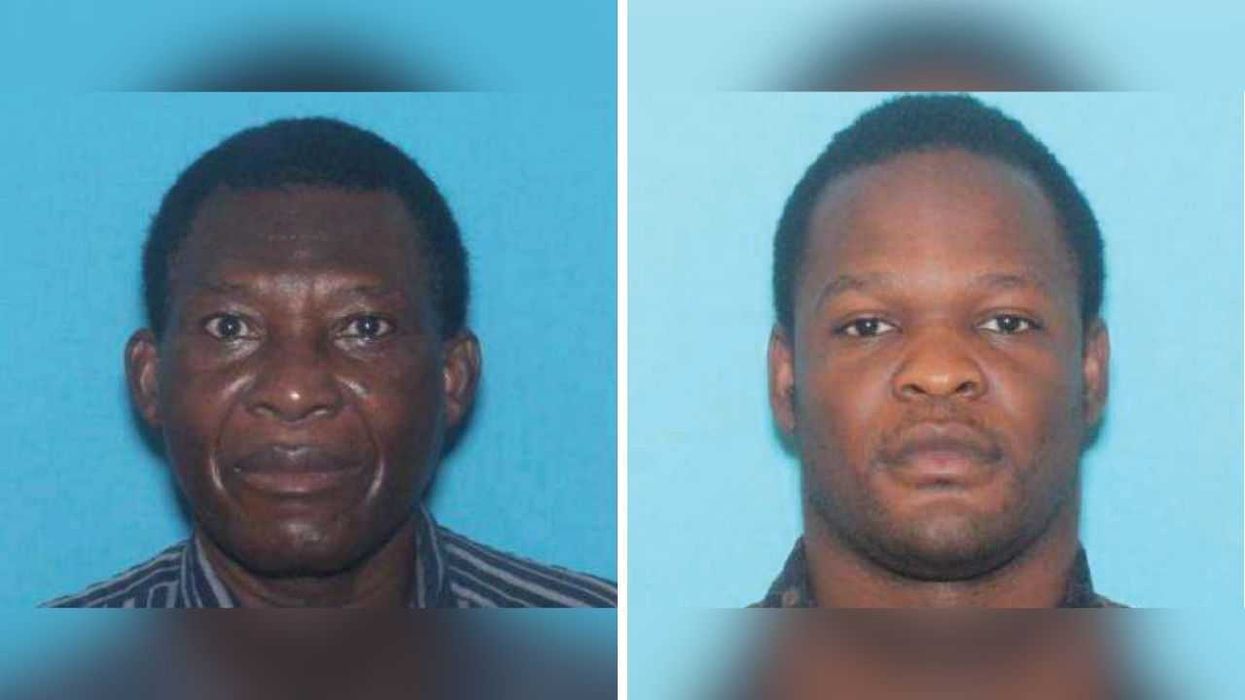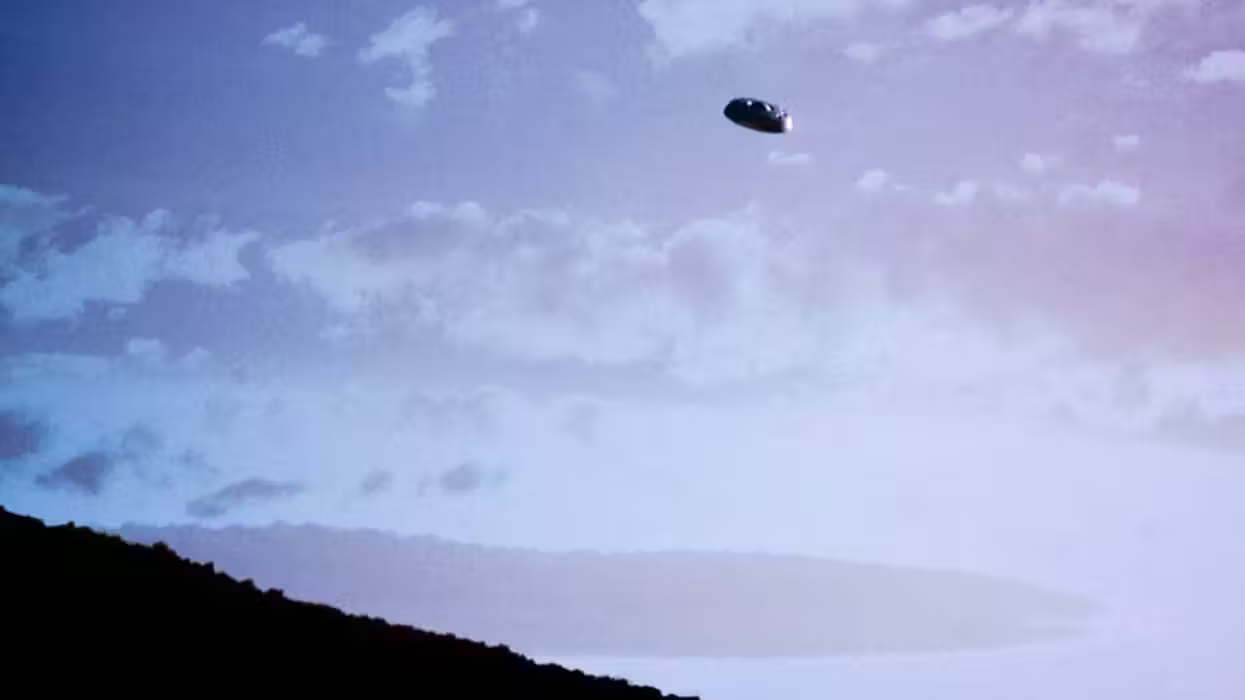ALBUQUERQUE, N.M. (AP) — Two pilots in a helium-filled balloon landed safely off the coast of Mexico early Saturday after an audacious, nearly 7,000-mile-long trip across the Pacific Ocean that shattered two long-standing records for ballooning.
 In this Monday, Jan. 26, 2015 photo provided by the Two Eagles Balloon Team, Troy Bradley of New Mexico and Leonid Tiukhtyaev of Russia set off from Saga, Japan, shortly before 6:30 a.m. JST Sunday, Jan. 25, 2015, in their quest to pilot their helium-filled balloon from Japan in a bid to reach North America and break two major records en route. (AP Photo/Troy Bradley, Two Eagles Balloon Team)
In this Monday, Jan. 26, 2015 photo provided by the Two Eagles Balloon Team, Troy Bradley of New Mexico and Leonid Tiukhtyaev of Russia set off from Saga, Japan, shortly before 6:30 a.m. JST Sunday, Jan. 25, 2015, in their quest to pilot their helium-filled balloon from Japan in a bid to reach North America and break two major records en route. (AP Photo/Troy Bradley, Two Eagles Balloon Team)
The pilots landed 4 miles offshore in Baja California about 300 miles north of the popular beach destination of Cabo San Lucas, greeted by a team of balloon enthusiasts who assisted with the landing. The pilots came in low and dropped thick trailing ropes into the ocean to help slow the balloon before setting down in a controlled water landing. The balloon will be towed to the coast.
Mission control in Albuquerque was packed with balloon team members and the pilots' families as it descended, with all eyes focused on a giant screen showing a map of the coast and the balloon's location. They exchanged hugs and smiled with relief after it touched down.
"We're really pleased with the distance numbers we have here and very pleased with the duration numbers," said Steve Shope, mission control director. "These are significant improvements over the existing records. We didn't break them by just a little bit. They were broken by a significant amount."
Troy Bradley of Albuquerque and Leonid Tiukhtyaev of Russia lifted off from Japan Sunday morning, and by Friday, they beat what's considered the "holy grail" of ballooning achievements, the 137-hour duration record set in 1978 by the Double Eagle crew of Ben Abruzzo, Maxie Anderson and Larry Newman in the first balloon flight across the Atlantic.
 In this Oct. 8, 2014 file photo, Albuquerque pilot Troy Bradley announces plans to fly across the Pacific Ocean with fellow pilot Leonid Tiukhtyaev of Russia as part of an effort to break a pair of long-distance and duration records that have stood for more than three decades, during a news conference in Albuquerque, N.M. (AP Photo/Susan Montoya Bryan, File)
In this Oct. 8, 2014 file photo, Albuquerque pilot Troy Bradley announces plans to fly across the Pacific Ocean with fellow pilot Leonid Tiukhtyaev of Russia as part of an effort to break a pair of long-distance and duration records that have stood for more than three decades, during a news conference in Albuquerque, N.M. (AP Photo/Susan Montoya Bryan, File)
They also easily exceeded the distance record of 5,209 miles set by the Double Eagle V team during the first trans-Pacific flight in 1981.
 Troy Bradley and Leonid Tiukhtyaev shattered records after flying a balloon from Japan to Baja California. (Image via Google Maps)
Troy Bradley and Leonid Tiukhtyaev shattered records after flying a balloon from Japan to Baja California. (Image via Google Maps)
The pilots were said to be in good spirits at various times during the trip, but it was a grueling ordeal. The balloon's capsule is about the size of a large tent — 7 feet long, 5 feet wide and 5 feet tall. They were flying at an altitude of at least 15,000 feet, requiring them to wear oxygen masks and bundle up against the 50-degree temperature inside the capsule. They had sleeping bags, a small onboard heater and a simple toilet.
The original route took the pilots on a path from Japan, across the Pacific Ocean and toward the Pacific Northwest before they encountered shifting weather patterns. They then made a sweeping right turn and headed south along the California coast for the Mexico landing.
By Saturday morning, the Two Eagles team had smashed the records, having traveled 6,646 miles over six days, 16 hours and 37 minutes.
"The technology has improved so much in the last couple of years. I don't think there's going to be any question about the records," said Katie Griggs, a regional director with the nonprofit Balloon Federation of America.
The world has been tracking their progress online and through social media sites.
Still, the official distance and time of the Two Eagles flight must be confirmed by the Federation Aeronautique Internationale, which requires staying aloft 1 percent longer and farther than the previous record.
The balloon is outfitted with an array of monitors and other instruments that are tracking its course and compiling the data, using technology that didn't exist in decades past, leaving some claims unproven.
The journey has been tough on the pilots, who have been on oxygen for days; high altitude can take a physical toll. But they've been managing to crack jokes when checking in with mission control and their families.
 Tami Bradley hugs her daughter, Savannah, moments after watching her husband, The Two Eagles balloon pilot Troy Bradley, and fellow pilot Leonid Tiukhtyaev surpass a gas ballooning distance record on a giant screen inside the mission control room in Albuquerque, N.M., on Thursday, Jan. 29, 2015. Bradley and Tiukhtyaev were crossing on The Two Eagles balloon across the Pacific Ocean on Thursday as part of their record breaking challenge. (AP Photo/Susan Montoya Bryan)
Tami Bradley hugs her daughter, Savannah, moments after watching her husband, The Two Eagles balloon pilot Troy Bradley, and fellow pilot Leonid Tiukhtyaev surpass a gas ballooning distance record on a giant screen inside the mission control room in Albuquerque, N.M., on Thursday, Jan. 29, 2015. Bradley and Tiukhtyaev were crossing on The Two Eagles balloon across the Pacific Ocean on Thursday as part of their record breaking challenge. (AP Photo/Susan Montoya Bryan)
Before the landing, though, the team was all business.
"Right now we have a big job ahead of us to get this balloon down," Shope said.

 In this Monday, Jan. 26, 2015 photo provided by the Two Eagles Balloon Team, Troy Bradley of New Mexico and Leonid Tiukhtyaev of Russia set off from Saga, Japan, shortly before 6:30 a.m. JST Sunday, Jan. 25, 2015, in their quest to pilot their helium-filled balloon from Japan in a bid to reach North America and break two major records en route. (AP Photo/Troy Bradley, Two Eagles Balloon Team)
In this Monday, Jan. 26, 2015 photo provided by the Two Eagles Balloon Team, Troy Bradley of New Mexico and Leonid Tiukhtyaev of Russia set off from Saga, Japan, shortly before 6:30 a.m. JST Sunday, Jan. 25, 2015, in their quest to pilot their helium-filled balloon from Japan in a bid to reach North America and break two major records en route. (AP Photo/Troy Bradley, Two Eagles Balloon Team)
 In this Oct. 8, 2014 file photo, Albuquerque pilot Troy Bradley announces plans to fly across the Pacific Ocean with fellow pilot Leonid Tiukhtyaev of Russia as part of an effort to break a pair of long-distance and duration records that have stood for more than three decades, during a news conference in Albuquerque, N.M. (AP Photo/Susan Montoya Bryan, File)
In this Oct. 8, 2014 file photo, Albuquerque pilot Troy Bradley announces plans to fly across the Pacific Ocean with fellow pilot Leonid Tiukhtyaev of Russia as part of an effort to break a pair of long-distance and duration records that have stood for more than three decades, during a news conference in Albuquerque, N.M. (AP Photo/Susan Montoya Bryan, File)
 Troy Bradley and Leonid Tiukhtyaev shattered records after flying a balloon from Japan to Baja California. (Image via Google Maps)
Troy Bradley and Leonid Tiukhtyaev shattered records after flying a balloon from Japan to Baja California. (Image via Google Maps)
 Tami Bradley hugs her daughter, Savannah, moments after watching her husband, The Two Eagles balloon pilot Troy Bradley, and fellow pilot Leonid Tiukhtyaev surpass a gas ballooning distance record on a giant screen inside the mission control room in Albuquerque, N.M., on Thursday, Jan. 29, 2015. Bradley and Tiukhtyaev were crossing on The Two Eagles balloon across the Pacific Ocean on Thursday as part of their record breaking challenge. (AP Photo/Susan Montoya Bryan)
Tami Bradley hugs her daughter, Savannah, moments after watching her husband, The Two Eagles balloon pilot Troy Bradley, and fellow pilot Leonid Tiukhtyaev surpass a gas ballooning distance record on a giant screen inside the mission control room in Albuquerque, N.M., on Thursday, Jan. 29, 2015. Bradley and Tiukhtyaev were crossing on The Two Eagles balloon across the Pacific Ocean on Thursday as part of their record breaking challenge. (AP Photo/Susan Montoya Bryan)






